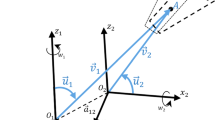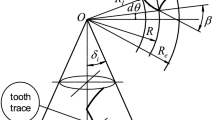Abstract
At present, most straight bevel gears use a root fillet transition surface with a radius of 0.3 modulus. This tends to cause excessive root bending stress and reduces the service life of bevel gears. In order to solve this problem, a root fillet transition surface controlled by a set of third-order Bezier curves is designed based on spherical involute tooth surface. In the common cone apex coordinate system of the bevel gear, the spherical involute tooth surface equations and the third-order Bezier curve equations controlling the root transition surface are established. The feasibility of gear manufacturing is verified by precision forging simulation. A Box–Behnken experiment was designed, and the response surface model was developed from the experimental results. The response surface model reflects the mathematical relationship between the four variables controlling the third-order Bezier curve and the maximum tooth root bending stress. Then, the nonlinear programming was used to optimize the four variables, and the optimal root transition surface was obtained.
















Similar content being viewed by others
References
Aksoy DO, Sagol E (2016) Application of central composite design method to coal flotation: modelling, optimization and verification. Fuel 183:609–616. https://doi.org/10.1016/j.fuel.2016.06.111
Ashby MF, Cebon D (1993) Materials selection in mechanical design. Le J De Phys IV 3(C7):C7–C1. https://doi.org/10.1051/jp4:1993701
Buckingham E (1988) Analytical mechanics of gears. Courier Corporation, Chelmsford
Dong P, Zuo S, Du S, Tenberge P, Wang S, Xu X, Wang X (2020) Optimum design of the tooth root profile for improving bending capacity. Mech Mach Theory 151:103910. https://doi.org/10.1016/j.mechmachtheory.2020.103910
Fang Z (1984) Laser speckle measurement and calculation of deformation of gear teeth under load. Gear 05:19-25+43
Hayalioglu M (2002) Erratum to: Optimum load and resistance factor design of steel space frames using genetic algorithm SMO Vol. 21, No. 4, pp. 292–299, 2001. Struct Multidisc Optim 23:404. https://doi.org/10.1007/s00158-002-0201-7
Heidari BS, Oliaei E, Shayesteh H, Davachi SM, Hejazi I, Seyfi J, Bahrami M, Rashedi H (2017) Simulation of mechanical behavior and optimization of simulated injection molding process for PLA based antibacterial composite and nanocomposite bone screws using central composite design. J Mech Behav Biomed Mater 65:160–176. https://doi.org/10.1016/j.jmbbm.2016.08.008
ISO 6336-3:2019-11 (2019) Calculation of load capacity of spur and helical gears—part 3: calculation of tooth bending strength. International Organization for Standardization
Landi L, Stecconi A, Morettini G, Cianetti F (2021) Analytical procedure for the optimization of plastic gear tooth root. Mech Mach Theory 166:104496. https://doi.org/10.1016/j.mechmachtheory.2021.104496
Lewis WM (1992) Lewis bending strength equations centennial investigation of the strength of gear teeth. Gear Technology 9:18–18
Miler D, Hoić M, Škec S, Žeželj D (2020) Optimisation of polymer spur gear pairs with experimental validation. Structur Multidiscip Optim 62(6):3271–3285. https://doi.org/10.1007/s00158-020-02686-1
Miler D, Lončar A, Žeželj D, Domitran Z (2017) Influence of profile shift on the spur gear pair optimization. Mech Mach Theory 117:189–197. https://doi.org/10.1016/j.mechmachtheory.2017.07.001
Niemann G (1960) Kegelräder und versetzte Kegelräder (Hypoidräder). In: Niemann G (ed) Maschinenelemente. Springer, Berlin. https://doi.org/10.1007/978-3-662-25357-1_4
Pedersen NL (2009) Reducing bending stress in external spur gears by redesign of the standard cutting tool. Struct Multidiscip Optim 38(3):215–227. https://doi.org/10.1007/s00158-008-0289-5
Rai P, Barman AG (2019) An approach for design optimization of helical gear pair with balanced specific sliding and modified tooth profile. Struct Multidiscip Optim 60:331–341. https://doi.org/10.1007/s00158-019-02198-7
Sankar S, Nataraj M (2011) Profile modification—a design approach for increasing the tooth strength in spur gear. Int J Adv Manuf Technol 55(1–4):1–10. https://doi.org/10.1007/s00170-010-3034-3
Shih YP, Huang YC, Lee YH, Wu J-M (2013) Manufacture of face-hobbed straight bevel gears using a six-axis CNC bevel gear cutting machine. Int J Adv Manuf Technol 68(9–12):2499–2515. https://doi.org/10.1007/s00170-013-4880-6
Spitas VA, Costopoulos TN, Spitas CA (2005) Optimum gear tooth geometry for minimum fillet stress using BEM and experimental verification with photoelasticity. ASME J Mech Des 128(5):1159–1164. https://doi.org/10.1115/1.2216731
Uelpenich R, Tenberge P (2019) Fast tooth root load capacity optimization based on improved design of hob geometry. In MATEC Web of Conferences (Vol. 287, p. 01011). EDP Sciences. https://doi.org/10.1051/matecconf/201928701011
Zhao X (2014) Increasing bending strength in spur gears using shape optimisation of cutting tool profile. Aust J Mech Eng 12(2):208–216. https://doi.org/10.7158/M13-027.2014.12.2
Zou T, Shaker M, Angeles J, Morozov A (2014) Optimization of tooth root profile of spur gears for maximum load-carrying capacity. In: Proceedings of the ASME 2014 international design engineering technical conferences and computers and information in engineering conference. Volume 2B: 40th Design Automation Conference. Buffalo, New York, USA. August 17–20, 2014. V02BT03A017. ASME. https://doi.org/10.1115/DETC2014-34568
Zou T, Shaker M, Angeles J, Morozov A (2017) An innovative tooth root profile for spur gears and its effect on service life. Meccanica 52(8):1825–1841. https://doi.org/10.1007/s11012-016-0519-7
Acknowledgements
This work was supported by National Natural Science Foundation of China (Grant Number: 51975295), Natural Science Foundation of Jiangsu Province (Grant Number: BK20190462), and Special Funds for Basic Scientific Research Business Expenses of Central Universities (Grant Number: 30919011203).
Replication of results
In order to verify the stability and repeatability of the design method in this paper, an additional gear was optimized. Its maximum bending stress on the tensile side of the tooth root before and after optimization is shown in Fig. 17. It can be seen that the maximum tooth root bending stress decreased by approximately 24.4%. The optimization effect is influenced by the basic parameters of the gear. Therefore, it shows that the optimized design method proposed in this paper is effective and stable.
Author information
Authors and Affiliations
Corresponding author
Ethics declarations
Conflict of interest
We declare that we have no financial and personal relationships with other people or organizations that can inappropriately influence our work, there is no professional or other personal interest of any nature or kind in any product, service and/or company that could be construed as influencing the position presented in, or the review of, the manuscript entitled, “Optimized design of straight bevel gear tooth root transition surface”.
Additional information
Responsible Editor: Josephine Voigt Carstensen
Publisher's Note
Springer Nature remains neutral with regard to jurisdictional claims in published maps and institutional affiliations.
Supplementary Information
Below is the link to the electronic supplementary material.
Rights and permissions
About this article
Cite this article
Zeng, H., Wang, L., Sun, H. et al. Optimized design of straight bevel gear tooth root transition surface. Struct Multidisc Optim 65, 36 (2022). https://doi.org/10.1007/s00158-021-03146-0
Received:
Revised:
Accepted:
Published:
DOI: https://doi.org/10.1007/s00158-021-03146-0





